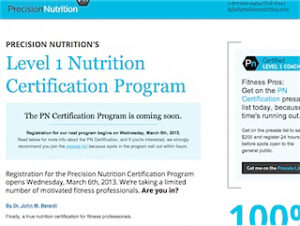You’ve been going to the gym for what seems like forever. The cute girl at the fitness shake stand knows you by your first name; the lug nut at the main desk doesn’t even bother checking your ID anymore; and the jack*ss who spends eight hours a day, every day, in the gym knows by now that you don’t want his unsolicited advice on how to properly perform each movement. Yet, in all that time you’ve never done anything different from the regular old run of the mill repetition. You begin with the weight at the bottom of the range of motion, you lift it as far as you can and then lower back it to the starting position–over and over and over again. Isn’t it time for a change?
Well, this might surprise you, but there are at least half a dozen variations on the common repetition. Each of these variations can add much needed diversity to your fitness arsenal. This isn’t intended to be an exhaustive list, but it is a good starting point. Over the next month or two I will look at each of these types of repetitions in more detailed reviews, but for now, enjoy the highlights.
Negatives– Although negatives are usually considered the ugly step sister of the positive rep, they offer considerable benefits when used individually. Consider this, your negative range of motion is usually 20-30% stronger than your positive range. For example, if your one rep max for bench press is 100lbs, you can perform negatives with anywhere from 120-130lbs. Why is this important? Because negatives allow you to stimulate your muscles to an even greater degree, bypassing the weak link in your repetition- the positive motion.
There are a few keys to a good negative repetition. First, you need a good training partner. Trust me, you don’t want to try these by yourself. Second, make sure that the weight is heavy enough that you can’t perform a single unaided rep with it, but not so heavy as to keep you from lowering the bar in a controlled manner. Take anywhere from 6 to 12 seconds to lower the bar from the top of the range of motion to the bottom. Many trainers who recommend using negatives recommend using no more than 2 – 3 reps per exercise since they are quite taxing on your muscles.
For more info check out the following links: A Primer on Eccentric [Negative] Reps, Think Negative, Think Negative to Grow.
Static Contraction– Beware, these appear easier than they really are. The static position is another position that you usually perform in a normal rep- except for the fact that you hold it for so short a time that you barely notice. You see the static position is the position at the top of the rep, right before your arms lock out when the weight stops moving and you are holding it in place. As you know any given rep has three parts: positive, negative, and static. As we said earlier your muscles are stronger in the negative range than the positive. Moreover, your muscles can hold much more weight in the static position than in either the positive or negative position. How much more? Well, somewhere between 55-75% of your one rep max. Once again, the strength of this variety of rep is that it allows you to bypass the weaker aspects of your common rep and hit your muscles where they are strongest with the heaviest weight possible.
Just like with negatives make sure you have a good training partner. Also, be sure that the weight isn’t so much that you can’t control the bar and hold it steady. The advocates for static reps recommend 2 to 3 reps (or you might look at it as 2 to 3 sets of 1 rep each) holding the bar for 8-15 seconds. MAKE SURE you DON’T lock out your joints, and make sure you hold the bar steady, no letting it start to enter the negative range of motion.
For more info check out the following links: Static Contraction Training and X-rep Training
Partial– You’ve probably done these before, you just didn’t know it. Only problem is you’ve probably done these when you were tired and couldn’t complete a full rep. But partial reps don’t have to be reserved solely for the end of your set- why not use them throughout? If, as they say, confusing your body with change-ups is good, partial reps are the ultimate change up.
How do you do them? Begin by mentally separating your rep into thirds or fourths. For example, in a bench press, in the first position the bar would be one inch from your chest; in the second position the bar would be about four inches from your chest; in the third position the bar would be about four inches from lock-out; and in the last position you would have your arms almost entirely extended (as always never fully lock-out your joints during any exercises). Now, instead of doing the normal bottom-top-bottom-top repetition movement, randomly move between the four positions in your range of motion. You don’t need to preplan this, just do it! [Represented numerically, a set might look something like this: 1-2-1-3-2-4-3-4-3-4-2-1-4-3-2-4-2-4-1-3-1-3-4, etc.] Go until you reach muscle failure.
For more info check out the following links: Power Partials and Partial vs. Full Reps.
Multiple Partial– This is a variation on the above method. I’ve seen it done a lot with bicep curls, but there is no reason it can’t be applied elsewhere. Begin by doing seven repetitions in only the first half of the range of motion, then (with no rest in between) do seven repetitions in the second half of the range of motion, and lastly do seven full repetitions. I’ll be honest, I don’t like these. But since you might find some redeemable quality in them I am including them in this post.
To be continued…
Over to you. Drop us a line on X/Twitter ( @scottbird ), or add a comment below.
Cheers.
NB : if you love talking about strength-training as much as I do, you might also like to check out the weekly newsletter. A regular dose of fitness-focussed discussions, absolutely free.
And if you'd like to check out any of the stuff mentioned above (or in the comments), swing by Amazon. Huge assortment of fitness gear.

What's This?
Straight to the Bar is the online home of fitness enthusiast Scott Bird, and looks at the many training approaches, essential techniques, uncommon exercises and superb equipment to help you become as strong as humanly possible. In short, this site is the home of all things strength.
images of strength

Want to see (and learn) more Feats of Strength like this? Dive in.
Just Joined Us? Try These.
- DIY: How to Build an Olympic Weightlifting Platform
Kat ‘The Mighty Kat‘ Ricker - Building A Neck Of Steel
Mike ‘The Machine‘ Bruce - Straight to the Grip Contest
Jedd ‘Napalm‘ Johnson - A Little Yoke Work : 10 Exercises for a Bigger Neck
Scott Andrew Bird - 29 Things to do with a Barbell in the Corner
Jason Kirby - Get Mental! The Psychology of Strength
Josh Hewett - Small Victories
Josh Hanagarne
If you enjoyed these, check out the complete ‘Best Of Straight to the Bar‘ list. Fantastic.
setting up a home gym?
If you’re getting ready to put together a solid Home Gym (fantastic thing), here’s how.
For more, swing by the full guide. Absolutely free.
And of course, you’ll find everything you need over in the SttB Strength Store. Massive range.
Ever Tried Kettlebells?
If you’ve seen people using them but never taken the plunge yourself, here are the ones I use personally. You can also pick up a book/DVD/course if you want to learn how to put them to work.
Converters and Calculators.
Before you start your fitness journey, it’s important to measure a few things.
Here’s how.
Ready To Learn Even More?
I love learning new skills, and the many seminars & workshops available are a great way to do that. If you’re looking for a specific type of workshop nearby, check out the ones on Dragon Door. Great mix of kettlebell and calisthenics-based offerings.

The Precision Nutrition Certification Program
The Precision Nutrition Certification Program.
If you’re a fitness professional and love the Precision Nutrition approach, check out their certification offering. To say it’s comprehensive is an understatement.
Wherever You Are, We Are.
In addition to the main site, you can share your strength-training passion with a like-minded community on :
Wherever you like to hang out, get your regular dose of strength. Straight to the Bar.








0 Comments